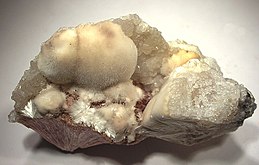Xonotlite
| Xonotlite | |
|---|---|
 Combination piece with radial fibrous inesite and xonotlite | |
| General | |
| Category | Inosilicates |
| Formula (repeating unit) | Ca6Si6O17(OH)2 |
| Strunz classification | 9.DG.35 |
| Dana classification | 66.3.1.1 |
| Crystal system | Monoclinic |
| Crystal class | Prismatic (2/m) (same H-M symbol) |
| Space group | P2/a |
| Unit cell | 879.33 |
| Identification | |
| Color | White, grey, pale pink, lemon white, colorless |
| Cleavage | Perfect, Good |
| Fracture | Splintery, tough |
| Mohs scale hardness | 6.5 |
| Luster | Vitreous, silky, pearly |
| Streak | White |
| Diaphaneity | Transparent, translucent |
| Specific gravity | 2.70 - 2.72 |
| Density | Measured: 2.70 - 2.72 Calculated: 2.71 |
| Optical properties | Biaxial (+) |
| Refractive index | nα = 1.583 nβ = 1.585 nγ = 1.595 |
| Birefringence | 0.012 |
| 2V angle | 50° |
| Ultraviolet fluorescence | Short UV = weak gray-white Long UV = weak white |
| Common impurities | Fe, Mn, H2O |
Xonotlite or eakleite is a mineral named by Karl Friedrich August Rammelsberg in 1866. The name originates from its discovery locality, , Puebla, Mexico. Although it was discovered in 1866, it was first described in 1959. It is approved by the IMA, but it is a grandfathered species, meaning the name supposedly represents a valid species til this day.[1]
Properties[]
Xonotlite is an ino-silicate with double dreier chains, of which several polytypes are known. The known polytypes are Ma2bc, Ma2b2c and M2a2bc. It is a mineral related to the tobermorite group. It can be colorless, gray, light gray, lemon white, or pink. It is transparent with a vitreous to silky luster. It leaves a white streak. Xonotlite is rated 6.5 on the Mohs scale of hardness. It crystallizes in the monoclinic - prismatic crystal system,[1] with typically an acicular crystal form or habit, meaning it occurs as needle-like crystals. It is massive, meaning individual crystals are hard to tell apart as they form large masses. It mainly consists of oxygen (42.52%), calcium (33.63%) and silicon (23.57%), and includes hydrogen (0.28%). It is a luminescent mineral, under short ultraviolet light it has a weak gray-white fluorescence, and under long UV it is weak white. It isn't a magnetic mineral, and is not radioactive.[2]
Environment and mining[]
It occurs as veins in serpentinite and contact metamorphism aureoles.[2] Associated minerals include apophyllite, diopside, stilbite, tobermorite, clinohedrite, thaumasite, laumontite and wollastonite.[3] The most common impurities include iron, magnesium and hydrogen dioxide impurities. It ihas many type localities, the most honorable one being Tetela de Ocampo, Mexico.[1]

References[]
- ^ a b c "Xonotlite". www.mindat.org. Retrieved 2021-11-08.
- ^ a b "Xonotlite Mineral Data". webmineral.com. Retrieved 2021-11-08.
- ^ "Xonotlite" (PDF). Mineral Data Publishing. 2001.
| Wikimedia Commons has media related to Xonotlite. |
- Calcium minerals
- Inosilicates
- Monoclinic minerals
- Minerals in space group 13
- Silicate mineral stubs